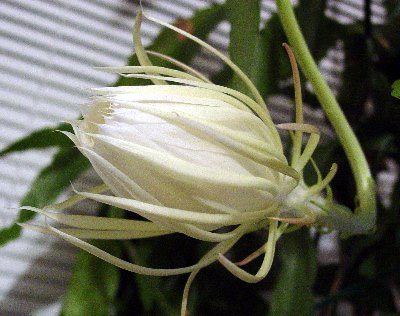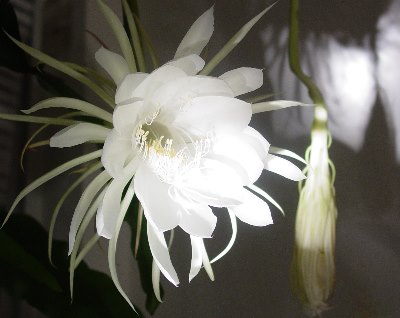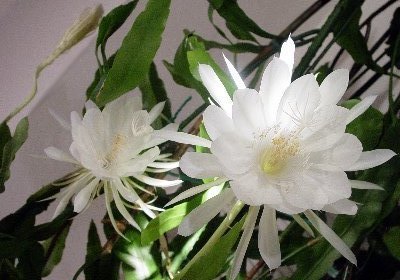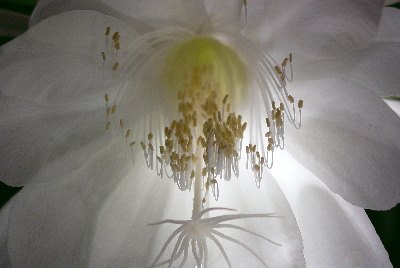|
|
Post by rockpickerforever on Jul 16, 2013 12:43:19 GMT -5
I've got several different types of epiphyllum (AKA orchid cactus) climbing up my hibiscus tree. A couple days ago, I saw that there was a flower bud from one of the larger flowering (entire flower almost a foot long!) species that was going to be opening shortly. A lot of people call this "Queen of the Night" but I think that name is more correctly used for a cereus species from AZ & NM. This may be Hylocereus undatus, which is a species of pitaya, native to Mexico, Central America and South America. It's also known as Dragon Fruit. The plant has been blooming for at least five years now, but no fruit has set yet. I have gotten the most blooms since I started "fertilizing" it with the water and rock debris from my flat lap! Decided to go out and get some photos of it last night. First photo taken before it got dark, around 7:30 pm.  Went back out around 8:30 with the flash. I use an old Sony digital video camera, that also take stills. When using the flash, I just have to guestimate the aperture opening. Basically, I cannot see anything in the viewfinder, I just point and shoot.  I heard some noise coming from less than ten feet in front of me - dead leaves and dried out hibiscus flowers, crackling and crunching. I thought it was just Lucy (my dog) sniffing around. I lifted up the camera and took anther blind shot and - Surprise! - this was heading my way. Fortunately, I think the flash kind of stunned him, and when I went and got a flashlight, I didn't see him anymore. Glad that he didn't stink! (He was still hanging around the yard several hours later. Don't know for sure if he is gone now or not.)  These flowers have a heavenly smell, some say it is something like vanilla. I think they smell like honeysuckle.  The next four shots were taken around 6am this morning.    Backed up about ten feet from the flower, and took this photo in daylight of where that skunk was at, and why he made so much noise as he ambled along!  Thanks for looking, I hope you liked the pics! Jean |
|
Deleted
Deleted Member
Member since January 1970
Posts: 0
|
Post by Deleted on Jul 16, 2013 13:15:35 GMT -5
Ahh.... the sweet smell of skunk. Hmm.....
Oops! I mean the sweet smell of cactus flowers..... haha!
I did enjoy all the images. Thanks so much.
|
|
|
|
Post by Pat on Jul 16, 2013 15:21:38 GMT -5
Lovely photos! Your cactus is new to me. Even skunks are attracted to a delightful aroma. Thanks!
|
|
jamesp
Cave Dweller 
Member since October 2012
Posts: 36,612
|
Post by jamesp on Jul 16, 2013 15:42:29 GMT -5
Skunk was attracted to Jean hahahah You know I love you Jean.
You have sensational plants. That is an awesome bloom. Your plants are healthy.
Glad the hydraulic oil did not do you in. That was a scare. I got pup pics this morn
They will start getting gone this week so I needed to get them in a batch pic.
|
|
grizman
freely admits to licking rocks
  
Member since July 2011
Posts: 878
|
Post by grizman on Jul 16, 2013 15:55:44 GMT -5
Very nice pictures of your special cacti and of course, the stripped kitty! I love my Montana wild flowers, but I have also taken 1,000's of photos of Arizona cactus flowers when we are down there for the winter and spring. Their color variations never ceases to amaze me.
|
|
|
|
Post by rockpickerforever on Jul 16, 2013 15:59:47 GMT -5
Can't wait to see your last pup pics, James. As for the hydraulic fluid mess, the company came through and paid us for our time to clean up the plants in front, and also paid a detailer to wax my trailer (after they had a company come out to get the oil off - with a degreaser - which stripped off the wax. Well, how else were they going to get it clean?)
Anyway, I'm pleased with how it was handled, I'm happier than a puppy with two tails!
|
|
|
|
Post by vegasjames on Jul 16, 2013 17:50:09 GMT -5
Yes, that is a pitaya, also known as night blooming cereus for obvious reasons or Cactus grandiflorus. The plant is naturally an epiphyte in jungles meaning is will grow on trees getting water and nutrients from water pockets in the nooks of trees.
It blooms once a year and can form delicious edible fruit. Another use is the leaves are a source of weak cardiac glycosides that slow and strengthen the heart while lowering blood pressure. Along with magnesium malate and coleus forskohlii Cactus grandiflorus is one of my favorite things for addressing heart arrhythmias.
They grow quickly and are easy to take care of. I have one growing here outside in a shaded area. Mine has not flowered yet though.
|
|
|
|
Post by helens on Jul 16, 2013 18:52:18 GMT -5
|
|
|
|
Post by vegasjames on Jul 16, 2013 19:26:10 GMT -5
There are more than 25 species of the plant.
|
|
panamark
fully equipped rock polisher
  
Member since September 2012
Posts: 1,343
|
Post by panamark on Jul 16, 2013 23:21:07 GMT -5
The night blooming cereus is typically pollinated in natural environment by bats who come to eat the pollen and nectar. Some large moths also pollinate it. They sure smell wonderfully sweet don't they? Very neat, thanks for sharing!
|
|
|
|
Post by rockpickerforever on Jul 17, 2013 12:19:12 GMT -5
Yes, that is a pitaya, also known as night blooming cereus for obvious reasons or Cactus grandiflorus. The plant is naturally an epiphyte in jungles meaning is will grow on trees getting water and nutrients from water pockets in the nooks of trees. Actually, James, the pitaya is not Cactus grandiflora, but rather Hylocereus undatus. Right or wrong (many different opinions on this!), many people use the name "night blooming cereus" for a variety of cactus types: As one person so aptly put it: I've been doing some online research, and now I'm even wondering if the pitaya is an epiphyllum. It does have the described growth form (epiphytic), but I read that epis have flat stems (yes, I have some of those, too), while the pitaya is triangular in cross section. Hmmmm. Too much to digest right now. Anyway, here's a few more pics, if you can stand it- This one is a cereus, and it blooms at night - Cereus jamacaru, another one frequently called "Queen of the Night."   It is originally from South America, and it spreads so rapidly it is considered an invasive species in South Africa. Monkeys and birds feed on the fruits, dispersing the seeds. It is a problem because "it competes with and replaces indigenous species, forming dense infestations which reduces the carrying capacity of the land and the many spines on the plants cause injuries to grazing animals." I can vouch for the spines!  At night  In the morning  Very pretty, though, and the bees love it. I took a video a year ago, with all the bees around the flowers. The buzzing is very loud! The flowers open at night, but will still be open in the morning, when the bees are around to pollinate them. It's not as fragrant a flower as the pitaya.  The flowers start to wilt not too long after the sun comes out. Like the pitaya, good for one night only. Here's a few more pics of the pitaya (this was taken a couple years ago)  Closing up after just one night, taken yesterday morning   Pics of a few other epis   Splatters on the leaves are from dumping the flatlap water. Although it looks a bit messy, they seem to like the minerals in it!  Tree trunk in background on left is my poor hibiscus, which is bending over from the added weight!      These last ones are at the north end of the yard. They are just sprawled on the ground, not climbing a tree for support.    And lastly, back to that skunk. I had blocked off where he had been going behind the garage. This is what he thought of that:  Yeah, he left this on my patio for me! I don't care for skunk poop, having to smell skunks, or my dog getting sprayed by them. He left his calling card around 5:30 this morning.  This means war! The live trap is being set tonight. Stay tuned for a report on how that goes. Thanks for looking (again)! Jean Edit to add - This website link has some great photos of the blooms to help you ID these beautiful plants! |
|
|
|
Post by vegasjames on Jul 17, 2013 18:19:07 GMT -5
Yes, that is a pitaya, also known as night blooming cereus for obvious reasons or Cactus grandiflorus. The plant is naturally an epiphyte in jungles meaning is will grow on trees getting water and nutrients from water pockets in the nooks of trees. Actually, James, the pitaya is not Cactus grandiflora, but rather Hylocereus undatus. Right or wrong (many different opinions on this!), many people use the name "night blooming cereus" for a variety of cactus types: Night blooming cereus is also a pitaya. Selenicereus grandiflorus is a pitaya (pitahaya) known as Night Blooming Cereus or Cactus grandiflorus. en.wikipedia.org/wiki/Selenicereus_grandiflorus"Selenicereus grandiflorus is a cactus species originating from the Antilles, Mexico and Central America. The species is commonly referred to as Nightblooming Cereus" www.thefreedictionary.com/Cactus+grandifloruswww.thefreelibrary.com/GARDENING+CACTUS+FRUIT+EDIBLE+BUT+NOT+ALL+IS+TASTY-a0207845231"A close relative of Epiphyllum is the vining pitaya cactus (Hylocereus and Selenicereus species), whose so-called dragon fruit have attractive magenta or yellow skin, and whose flavor varies from bland to magnificent, depending on the cultivar. " Plants can also sometimes have multiple botanical names. For example, Madagascar periwinkle used to be known as Vinca rosea and is now known as Catharanthus rosea. There can be various reasons for the multiple botanical names. For example, names are changed to avoid confusion. Or the plant may have been discovered in different places and given different names on the discovery. Plants may be re-classified, etc. In this case the botanical names Cactus grandiflorus and Selenicereus grandiflorus are synonymous. By the way Echinopsis and Trichocereus species are not epiphytes and both contain mescaline and so have different uses. |
|
|
|
Post by rockpickerforever on Jul 17, 2013 21:13:49 GMT -5
It is very confusing, what with all the reclassifications and people throwing around the same common name for different plants. I didn't say they were epiphytes, I said that they are also called "night-blooming cereus." From Wiki - link - sorry I didn't reference the source previously. |
|
Deleted
Deleted Member
Member since January 1970
Posts: 0
|
Post by Deleted on Jul 17, 2013 22:53:49 GMT -5
Skunk-scat ---------------------------------
yuk
|
|
|
|
Post by rockpickerforever on Jul 18, 2013 11:32:56 GMT -5
And now for the skunk update: Short story, caught him. The long version - Went outside at about 9:30 last night to set the trap with some canned dog food and a piece of cantaloupe. As I went out the back door, here he was again, walking right towards me. I shined my flash light in his face, and told him to git. He turned around, and headed towards the street, going under the center of the gate that separates the side yard from the driveway. At this point, I couldn't see where he went, didn't know if he went under the front gate, or if he was under the truck, or somewhere else out in front. I walked out to the end of the driveway, and was searching the street with the flashlight, to see if I could spot him. About this time, my next door neighbor is leaving her house with a car-full of kids, and asks me if I "saw that?" I replied, "Did you see that?" It scared the heck out of her, she'd never seen one of them up close and personal. I told her I was going to set a live trap for it. So now I'm wondering if she saw it first, or if I did? Meaning, was it in her yard before it came over here, or after it left here? Or was t still somewhere in my yard? I decided it would be prudent to find it. So, with as many lights illuminating the front yard as I could get, I started searching, and sure enough, there he was beside the shed in the front yard. I opened up the front gate, and my husband went around the back of the shed and "encouraged" the skunk to leave with a few blasts of water from one of those pressurized tanks filled with water, kind of like a refillable fire extinguisher. The skunk left, went out the gate, crossed the street and went down alongside that neighbor's house. Shortly after this episode, I went ahead and baited and set the trap, then covered the majority of it with an opened-up cardboard box. I have a neighbor a couple blocks away that routinely catches skunks in his yard and relocates them. He told me they won't spray you if they don't see you. I've only done this once before, and that skunk DID spray. He didn't hit me, but I was still a casualty by just being in the vicinity, collateral damage. The skunk last night, in the several nights he has been in our yard, has not sprayed a single time (just left calling cards, yuk!). This morning, I could hear something banging around in the trap when I opened the back door to take the dog out. I told my husband it was either the skunk, or a certain cat that keeps getting in my yard. Turned out I'd caught the skunk.    Now the tricky part - removing the box and covering the cage with a plastic trash bag, and tying it on so that it didn't blow off before I could release him. I tied it on, being certain to keep it off the end that drops so I could release him without too much fuss, and was able to carry the caged skunk out to the truck and load him in. So far, so good! I drove him around to the other side of the lake I'm near. There are no homes in the immediate area (didn't want him to be a problem for someone else!), and there's actually a wildlife refuge there. I just pulled the truck over, and parked in front of the gate. I dropped the tailgate, got the cage out and set it on the ground, taking care that he didn't see me through the uncovered end. I pulled the pin, allowing the end to drop open, and  he sauntered off. He never did spray, for which I am thankful! And only two cars passed me while I had the cage on the ground to release him - no hassles, thankfully. I still have to clean out the back of my truck (more skunk scat, Scott!), and hose the cage off. I'll be setting the trap again tonight, just in case there's more than one! Hope you enjoyed my story. Jean |
|
Deleted
Deleted Member
Member since January 1970
Posts: 0
|
Post by Deleted on Jul 18, 2013 11:49:38 GMT -5
Looks like a young one!
Shoulda took him to the vet and had him descented.
oooooooo there is definitely more than one!
|
|
garock
fully equipped rock polisher
  
Member since February 2006
Posts: 1,168
|
Post by garock on Jul 18, 2013 13:56:05 GMT -5
Jean ! Love the pictures and the story. I have only seen on skunk and it was while I was camping on Huntsville Lake in Alabama. I just let him tend to his business and left him alone !
|
|
Deleted
Deleted Member
Member since January 1970
Posts: 0
|
Post by Deleted on Jul 18, 2013 15:05:37 GMT -5
We have a local lake. Puddingstone Lake inside of Bonelli Park. The campground and surrounding area has perhaps a thousand skunks. The permanent campers feed them, plus the area seems to just have a lot of skunks. They are everywhere in the nearby town of San Dimas too. If you are up late sharing adult beverages with friends, it is not uncommon to have 5-6 in your field of vision at any given time. I love skunks.  |
|
|
|
Post by Bikerrandy on Jul 18, 2013 20:49:18 GMT -5
Great shots! The skunk is a cute little guy  |
|
jamesp
Cave Dweller 
Member since October 2012
Posts: 36,612
|
Post by jamesp on Jul 19, 2013 9:43:47 GMT -5
|
|
































































